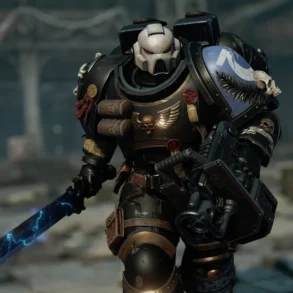A little imagination can go a long way, especially when you’re a bored child living literal miles from the nearest social center. As a kid, my action figures were pivotal to keeping my mind engaged and excited. Whether it was He-Man baddies clashing with Teenage Mutant Ninja Turtles, or my sister’s Cabbage Patch Kids being a massive boss for the Ghostbusters to fight, there was a neverending supply of what could be at my fingertips. Even the toys I made myself – paper cutouts with hastily drawn faces on the front – provided the extra characters that I didn’t get from the store.
Diorama Dungeoncrawl – Master of the Living Castle is a playful take on the traditional hack and slash formula by boiling it down into something both nostalgic and contemporary. With a rather simplistic setup – some kind of evil living in a castle and you need to go kill it – Renegade Sector Games thrusts players into a 2.5D situation of combat and survival. Your character, a nameless knight/warrior, has to progress through seven levels of monsters, traps and poor depth perception in order to defeat The Heart of the Castle and win the game. To do it, you’ll have your trusty warhammer and…that’s it. No other weapons or helpers are here, so I hope you’re ready to be a carpenter.
What’s rather fun about Diorama Dungeoncrawl is the evocative nature of the entire experience. Very often, when we throw back to oldschool games, we either end up with the NES era or possibly SNES, embroiling modern players in the 8 or 16 bit graphical worlds. By comparison, this quest feels a lot more in the pocket of Commodore 64. The colors are stark but bright, and the design feels very deliberate, like there was a larger, grander model that was shrunk down and crafted into something squat without fully recalibrating the original photo. This is a clear nod to the diorama approach, which is honestly quite clever. The set pieces evolve well as you move forward, and the choice to have more washed out background notes versus the sharper foreground images capture the idea perfectly.
The movement and controls are very, very spotty, and I’m still torn if this is a game where you need to learn to play or if it’s just wonky. The forced perspective and the 3D but 2D effect crafts two different but equally important problems. First, the out of bounds regions. You early on learn that there is an element of platforming that comes into the game, and this makes for some very awkward and painful learning experiences. While there isn’t fall damage per say, there is fall death when you land into darkness, and it’s very easy to end up there when you’re not intending to. Trying to gauge exactly how far and well you’ll be able to make an uninterrupted jump isn’t the most intuitive thing, but that could be intentional. It doesn’t mean I like it, but I’ll pretend that constant failing is a purposeful design.
The second problem, and one that feels more extreme, are the hit boxes and collisions. Since we’re working in two different kinds of displays at once, you end up with a strange sensation of being quite invulnerable throughout the game. At the start, when enemies are simpler and more physical, you’re more apt to end up getting hit by things as they use their whole bodies as weapons. The first couple of bosses, including a massive bear that just LEAPS through the air, were pretty tough because I couldn’t tell how many pixels they occupied. When you’re trying to avoid being hit but also want to be close enough to launch a counter attack, the whole ursine death thing is very near, apparent and real.
This is the second game by EastAsiaSoft where I’ve been in this position from a bear.
By contrast, later bosses in Diorama Dungeoncrawl tend to focus more on being fancy and using projectiles, and that doesn’t work out so well for them. Energy balls and evil spells take up a small amount of room, and a literal sidestep gets you out of harms way. After a mini boss of a gelatinous cube that was wildly tricky to anticipate, the Lich who summons a couple of skeletons and then throws three janky spells was really simple. Not all bosses remain that easy, but the dude in the giant cannon mech went down without much fuss. It really becomes that getting to the bosses is the real challenge in terms of traps and enemies, but the bosses themselves are just a neat little button at the end of the stage.
I suppose Diorama Dungeoncrawl is compelling enough in terms of gameplay, though it really does its best to set up players to win. The drops from vases and such are always recharges for your special attack, which charges up and fires in an awful hurry. While there’s a few different special attacks to be found, the radius attack (blast of energy for one tile in each direction) is the most powerful and should be held onto at all cost. Since knockback seems to apply itself arbitrarily to enemies and the player character, just being able to give yourself a bit of breathing room is so important. If you die, you automatically spawn at the last checkpoint you touched, and those are pretty generously sprinkled in, so there’s not a lot of stress in terms of death. Frustration, sure, especially if said knockback suddenly flings you off a ledge, but that’s just an annoyance at best.
This is a classic-feeling game in the best sense of the word. The graphics are a little murky but surprisingly detailed when you get a better look at them (dock your Switch to really appreciate the boss models). The music is very repetitive BUT is shockingly complex and really worms its way into your ears as you’re fighting your way to the top: it almost felt tribal at times. And while the full game loop is conservatively an hour (probably less with practice), it has enough variety to keep you on your toes. Spike traps, rolling boulders, sweeping lasers that shouldn’t be there but why not, this is a game…it’s pretty elaborate. I have to hand it to Renegade Sector Games for crafting something fairly entertaining.
Honestly, I would much rather pick up Diorama Dungeoncrawl and wallop my way through a fistful of screens than stare at the average puzzle game on my smartphone, and these fun, engaging experiences require buttons and joysticks to fully appreciate. It’s a quaint little bit of brutality, and I would absolutely recommend it to someone who’s looking for a bit of an afternoon romp. Hammy, violent and detailed, this diorama gets first prize.
|
Graphics: 5.5 Surprisingly detailed and refreshing in concept, these lovely setpieces really pop on larger screens, but, sadly, are a bit muddled when it comes to the Switch’s handheld view. |
Gameplay: 6.5 While simplistic in concept, figuring out what needs to be done to survive in terms of gauging distance and depth are a bit frustrating. Once you get proper reading perception, the hack and slash approach goes into overdrive. |
|
Sound: 7.5 I was shocked by how much I liked the musical loop! Rather than just be gothic and dark, it’s got some funk and vibe to it that keeps you bopping even as you die and respawn over and over. |
Fun Factor: 6.5 This is a “why not” kind of game if I’ve ever played one. I’ve never heard of it, but I was really engaged and excited to progress even as I moved through the castle. I’d absolutely pick it up again in the future when I have no idea what to play, because, well, why not? |
|
Final Verdict: 6.5 |
|
Diorama Dungeoncrawl: Master of the Living Castle is available now on XBox Series One X/S, Playstation 4/5, PC and Nintendo Switch.
Reviewed on Nintendo Switch.
A copy of Diorama Dungeoncrawl: Master of the Living Castle was provided by the publisher.
Check these out!
This post was originally published on this site be sure to check out more of their content.




